# Jira
SUMMARY
- Workato's Jira connector synchronizes projects and issues between Jira and other systems such as Zendesk, ServiceNow, and Salesforce's Desk.com (opens new window).
- This connector supports Jira cloud, Jira Data Center, and on-premise instances version 7.x and later.
- We recommend using API tokens, OAuth2.0, or personal access tokens for authentication.
- On-prem Jira connections support basic authentication with passwords. OAuth2 is not supported for on-prem Jira connections.
- Jira users with login access can connect using their credentials, but we recommend creating a separate user with Jira Administrator global permissions.
Jira (opens new window) provides a simple way to organize and plan the release of any software. This allows development teams to lay out key steps to follow when releasing the software including:
- Plan
- Track
- Release
- Report
You can use Workato to sync projects and issues between Jira and other issue tracking systems, such as Zendesk, ServiceNow, and Salesforce's Desk.com (opens new window).
# Use cases
Explore Jira connector capabilities with our use cases documentation. Discover how you can use the Jira connector to create powerful multi-app workflows and automations:
- Provision Jira and Okta usersfor new employees in Workday.
- Create or update Jira issues from new PagerDuty incidents.
- Create Jira issues for new ServiceNow incidents.
# API version
The Jira connector uses the Jira Cloud REST API v2 (opens new window).
# Supported editions and versions
The Jira connector works with:
- Jira cloud instances
- Jira on-premise instances version 7.x and later
- Jira Data Center, which is a new licensing model that replaces Jira Server
# How to connect to Jira on Workato
There are four ways to connect to Jira:
DEPRECATED PASSWORD AUTHENTICATION
From 1 December 2018, Atlassian is deprecating basic authentication with password for Jira (cloud only) in favor of API tokens. On-premise Jira will not be affected.
We strongly recommend using API tokens, OAuth2.0, or personal access tokens to connect to Workato.
# API tokens
API tokens are the primary method to authenticate with Jira. For on-premise Jira, you can only use basic authentication with password.
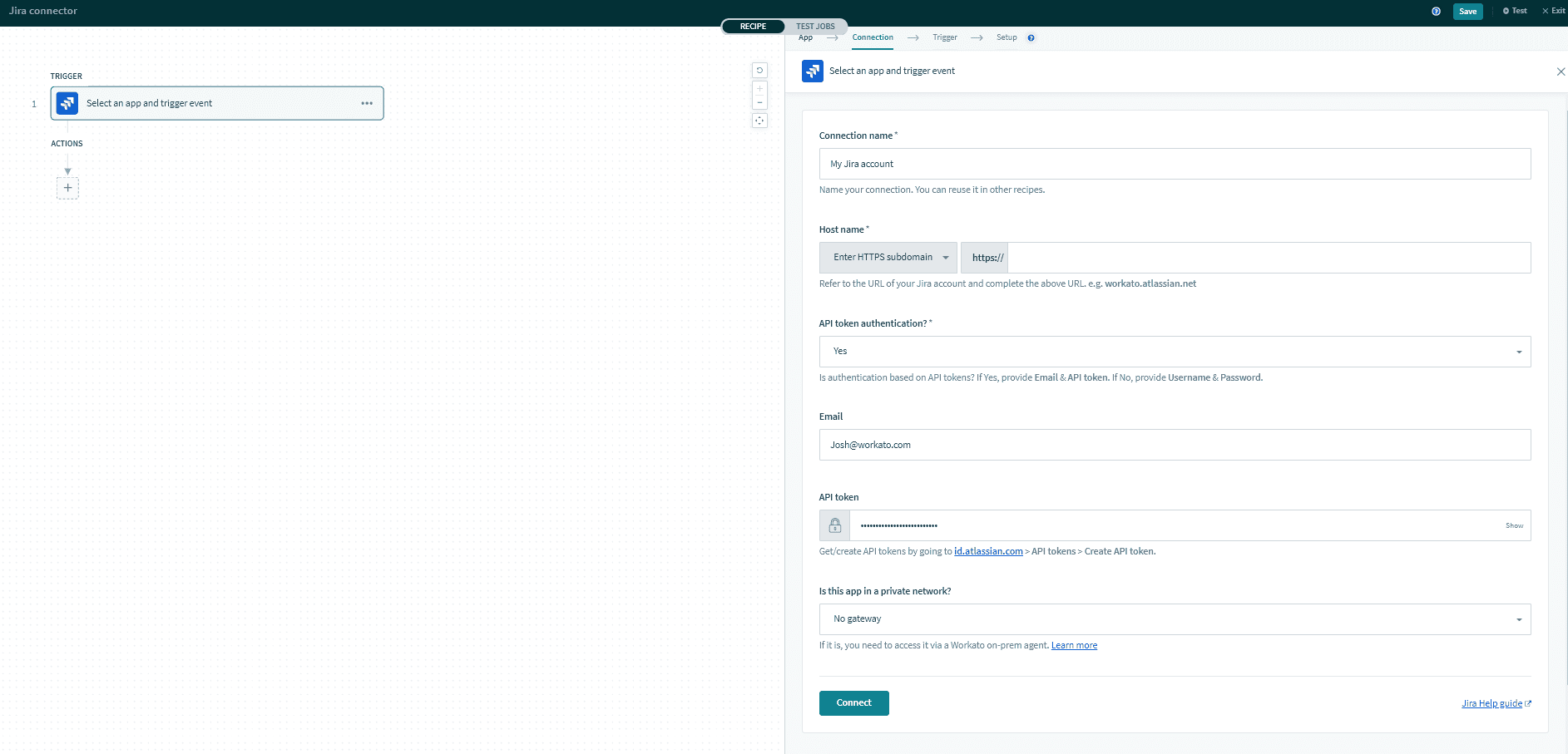 API token auth
API token auth
Connection name Give this Jira connection a unique name that identifies which Jira instance it is connected to.
Host name Complete Jira instance URL used to log in to Jira.
API token authentication? Set this to 'Yes' to authenticate using API tokens. You must then provide an email and API token. Set this to 'No' to authenticate using basic authentication with password.
Email Email of Jira account to link to Workato.
API token To create an API token from your Atlassian account:
2Click Create API token.
3Add a Label to the API token.
4Use Copy to clipboard, then return to your Jira connection in Workato and paste your API token.
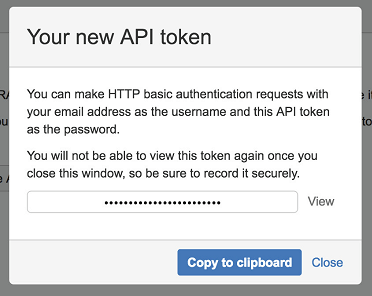
Is this app in a private network? To connect to on-premise Jira instances, set up the on-prem agent (opens new window). Ability to use the on-premise access functionality depends on the Workato plan subscribed to.
# OAuth2.0
OAuth 2.0 enables you to share specific data with an application while keeping your username, password, and other information private.
# OAuth2.0 limitations
OAuth2.0 has the following limitations:
OAuth2.0 does not support real-time triggers.
- OAuth2.0 is incompatible with webhook-based triggers. We recommend that you authenticate using an API token. If you plan to use the static webhook functionality offered by Jira, we recommend using the Webhooks connector in Workato and registering it in Jira as described here (opens new window).
OAuth2.0 does not support Jira connections for on-prem users.
 OAuth 2.0 auth
OAuth 2.0 auth
Complete the following steps to authenticate through OAuth2.0:
Select OAuth2.0 as the authentication type and enter your Jira Service Desk subdomain.
Select advanced settings and select the authorization scopes you plan to request. Otherwise, Workato requests the following scopes by default:
read:jira-userwrite:jira-workmanage:jira-projectread:jira-workmanage:jira-webhook
Click Connect and log into your Jira Service Desk instance using the account username and password in a separate window when prompted.
Authorize Workato's request to access your Jira Service Desk instance.
# Personal access tokens
You can create a personal access token in your Jira profile page.
Open Jira and select your profile picture at the top right of the screen.
Select Profile > Personal Access Token > Create token.
# Basic authentication with password
Basic authentication with password can be used to authenticate with Jira.
DEPRECATED PASSWORD AUTHENTICATION
From 1 December 2018, Atlassian is deprecating basic authentication with password for Jira (cloud only) in favor of API tokens. On-premise Jira will not be affected.
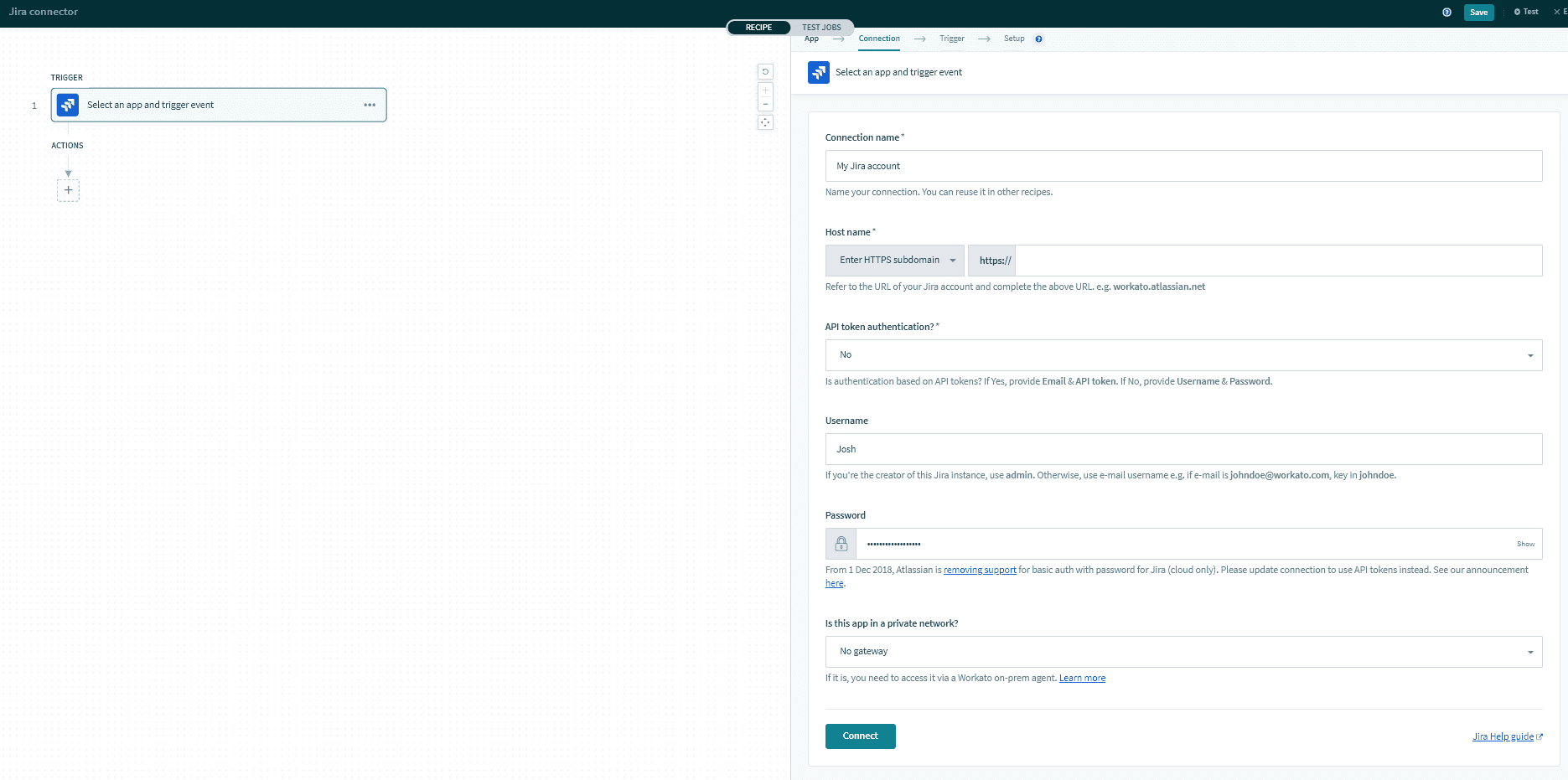 Basic password auth
Basic password auth
Connection name Give this Jira connection a unique name that identifies which Jira instance it is connected to.
Host name Complete Jira instance URL used to log in to Jira.
API token authentication? Set this to 'No' to authenticate using basic authentication with password. You must then provide a username and password. Set this to 'Yes' to authenticate using an API token.
Username Username to connect to Jira.
Password Password to connect to Jira.
Is this app in a private network? To connect to on-premise Jira instances, set up the on-prem agent (opens new window). Ability to use the on-premise access functionality depends on the Workato plan subscribed to.
# Roles and permissions required to connect
Jira, Jira cloud, and Jira Data Center users who have login access to their Jira instance can connect to Workato using their credentials. However, we recommend that a separate user (with Jira Administrator global permissions) be created for integration purposes.
Jira connection respects the project permissions schemes in your Jira project. You must ensure that your Jira account has sufficient permissions to perform the desired actions on the relevant Jira objects.
# Jira project permissions
There are three main ways a user can have access to objects within a project:
- People
- Issue security schemes
- Permission schemes
# People
Users can be added to a project (opens new window) (through Project Settings > People) using two methods:
Searching for and selecting a specific user, and then specifying the user's project role.
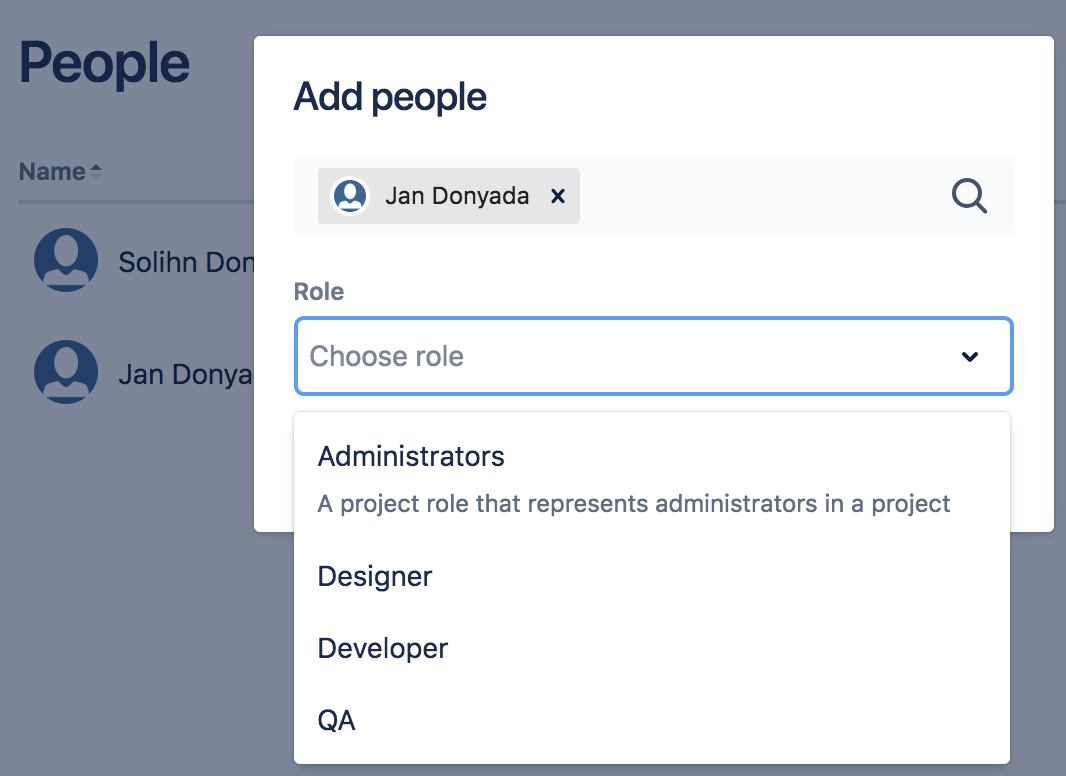 Choosing a project role for a user Jan Donyada
Choosing a project role for a user Jan DonyadaProject roles allow users to be associated with functional roles. For example, if your organization requires all software development issues to be tested by a QA person before being closed, you could:
- Create a project role called QA.
- Create a permission scheme called Software Development, in which you assign the Close issue permission to the QA role.
- Associate the Software Development permission scheme with all software development projects.
- For each software development project, add your QA engineers, assigning them the QA project role.
Searching for a Group and then specifying the group's project role.
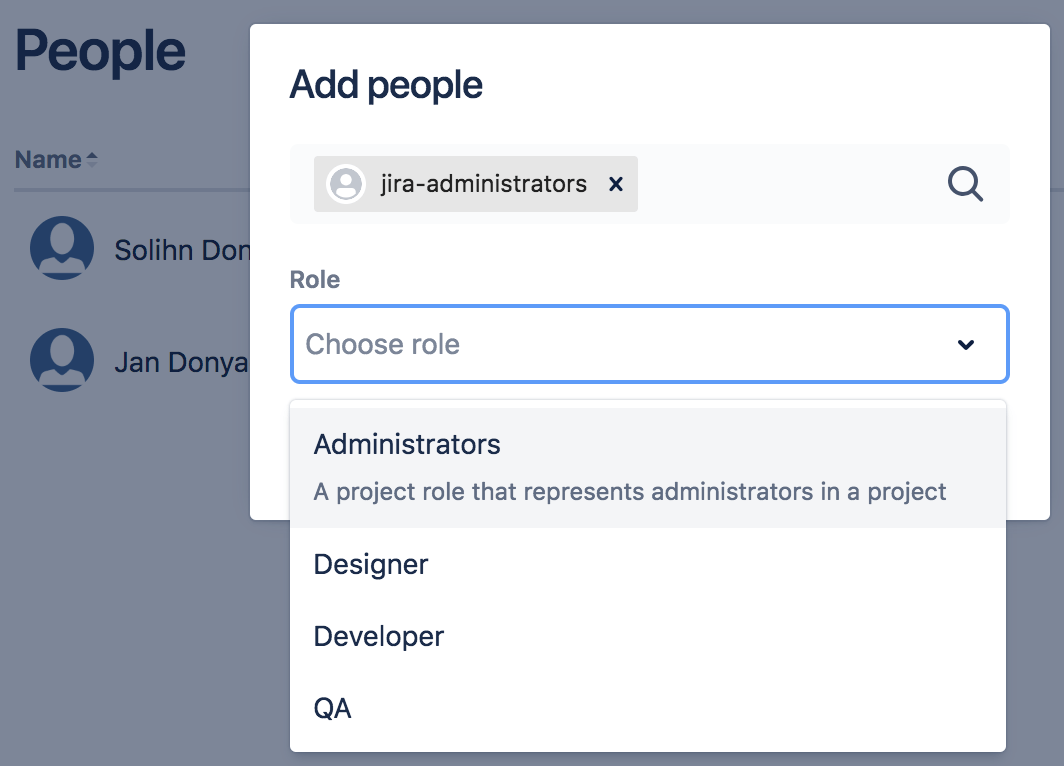 Choosing a project role for a the Jira Administrators group
A 'group' contains multiple members. Groups are similar to project roles, but with one key difference: group membership is global whereas project role membership is project-specific. Also, group membership can only be altered by Jira administrators, whereas project role membership can be altered by project administrators.
Choosing a project role for a the Jira Administrators group
A 'group' contains multiple members. Groups are similar to project roles, but with one key difference: group membership is global whereas project role membership is project-specific. Also, group membership can only be altered by Jira administrators, whereas project role membership can be altered by project administrators.
# Issue security schemes
Issue security schemes (opens new window) can be created and added to each project, allowing control over who can view and edit the issues of the project.
A scheme can have several security levels, and users or groups of users can be assigned to each security level. This ensures that only users who are assigned the appropriate security level can view the issue.
If your project has a defined issue security scheme, your linked Jira account must be a member of the appropriate security level in the security scheme. Typically, a security level's members include:
- Individual members
- Groups
- Project Roles
- Issue roles such as:
- Reporter
- Project Lead
- Current Assignee
- Anyone (for example, to allow anonymous access)
In the following example, the issue security scheme has a defined security level which allows access to only certain users, groups, and project roles.
 Only user 'Jan Donyada', users in the 'Jira Administrators' group, and users with the 'QA' project role have access to the issues, as defined by the 'Top-secret' security level
Only user 'Jan Donyada', users in the 'Jira Administrators' group, and users with the 'QA' project role have access to the issues, as defined by the 'Top-secret' security level
# Permission Schemes
Project permissions are created within Permissions schemes, which are then assigned to specific projects by your Jira Administrators.
Permissions can be granted for specific actions like creating issues, edit issues, assign issues, and so on. Permissions can be found by selecting Project Settings > Permissions.
Each permission can be granted across:
- Project roles
- Applications (JIRA, JIRA Service Desk, Jira Data Center, and more.)
- Groups
# 1. Project role
If a permission scheme associated with a project has defined role-specific permissions for specific actions, your linked Jira account must be assigned the same role to be authorized to use those actions in your Workato recipes.
For example, in the project permission scheme below, only the QA role has been permitted to perform the Close Issues action.

If the Workato recipe wants to perform any Close issue actions, the linked Jira account must also be assigned the role QA for the action to be authorized.
# 2. Application access
Application access settings let you control which person has access to which products. If your site only has one product (for example, if you have a Confluence-only or Jira-only instance), users are automatically granted access to that product when they sign up.
If your Workato recipes only need to perform specific actions on your Jira Software instance, then Jira Software must be selected for those actions.
Only users of Jira Software are permitted to assign issues
Likewise, if your Workato recipes only need to perform specific actions on your Confluence instance, then Confluence must be selected for those actions.
If your Workato recipes performs specific actions on both Jira Software & Confluence, then Any logged in user must be selected for those actions.
Any logged in user of either Jira Software or Confluence is permitted to assign issues
# 3. Groups
If a permission scheme associated with a project has defined group-specific permissions for specific actions, your linked Jira account must be a member of that group to be authorized to use those actions in your Workato recipes.
The Jira Administrators group is permitted to manage sprints
# Supported Jira actions and their required permissions
# Upload/download actions
To use the upload and download attachment actions, your linked Jira account must be added to the permissions under the Attachment Permissions tab of the permissions page.

# Comments triggers and actions
To use triggers and actions relating to Comments, your linked Jira account must be added to the permissions under the Comments Permissions tab of the permissions page.
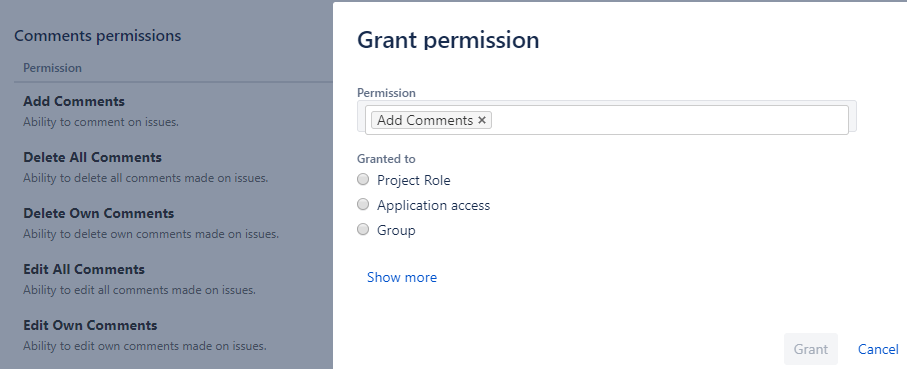
# Issues triggers and actions
To use triggers and actions relating to Issues, your linked Jira account must be added to the permissions under the Issues Permissions tab of the permissions page.
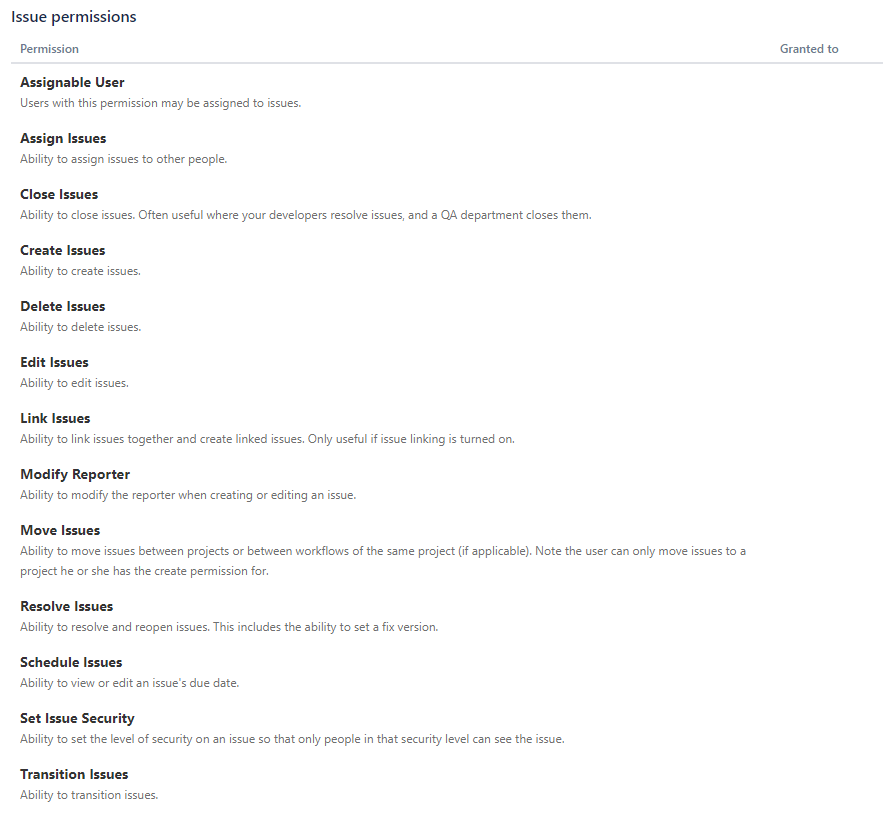
If the JIRA user does not have access to an object through any of the above methods, the object cannot be retrieved from the JIRA project, and will return a '403 - Forbidden' error.
For a comprehensive guide on how to manage project permissions, head over to Jira's permissions guide (opens new window).
To troubleshoot why a user is unable to access or perform actions on certain projects, issue types, or fields, you can use the Jira permission helper (opens new window).
# Jira permissions helper
You can use the Jira permissions helper to find out why a user is unable to view/edit certain projects or fields.
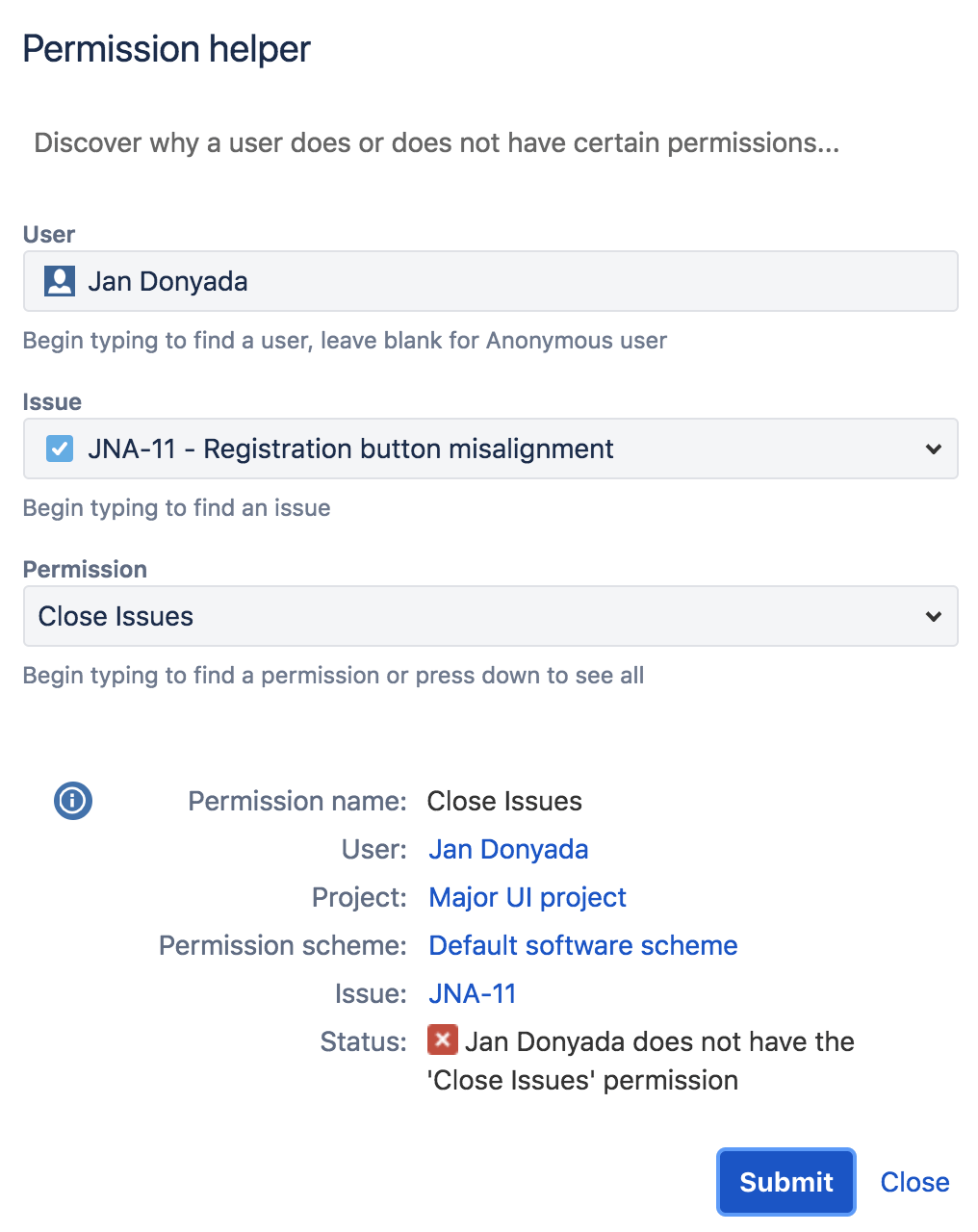
To utilize this, you'll need to have Jira Administrator access to your Jira instance. Learn more by heading over to Jira's permissions helper guide (opens new window).
# Using Jira real-time triggers
To use Jira real-time triggers, a webhook must first be registered in your connecting Jira instance. Registering webhooks to Jira instances requires Jira Administrator global permissions.
If your linked Jira account has Jira Administrators global permissions, then Workato automatically registers a webhook in your Jira instance when your Workato recipe (containing a Jira real-time trigger) is started for the first time.
For more information on Jira administrators & global permissions, check out Jira's global permissions guide (opens new window).
If your linked Jira account does not have Jira Administrators global permissions, you will not be authorized to register webhooks, and will require assistance from a user with Jira administrators global permissions to register one for you. You can still perform a Jira real-time trigger, but you'll have to use a webhook trigger with the Webhooks connector instead.
# Registering a webhook trigger as a Jira Administrator
If you're a Jira Administrator with global permissions, you can register a webhook for your fellow Jira instance users who want to use it for their HTTP webhook trigger recipes.
This can be done from the Jira administration console. For more information on how to register a webhook through the Jira administration console, check out the Jira guide on registering a webhook (opens new window).
# How to register a webhook
Go to Jira administration console > System > Webhooks.
 You should see a list of webhooks in the webhook summary page
You should see a list of webhooks in the webhook summary page
Click Create a webhook in the top right-hand corner of the page. This should open the webhook form.
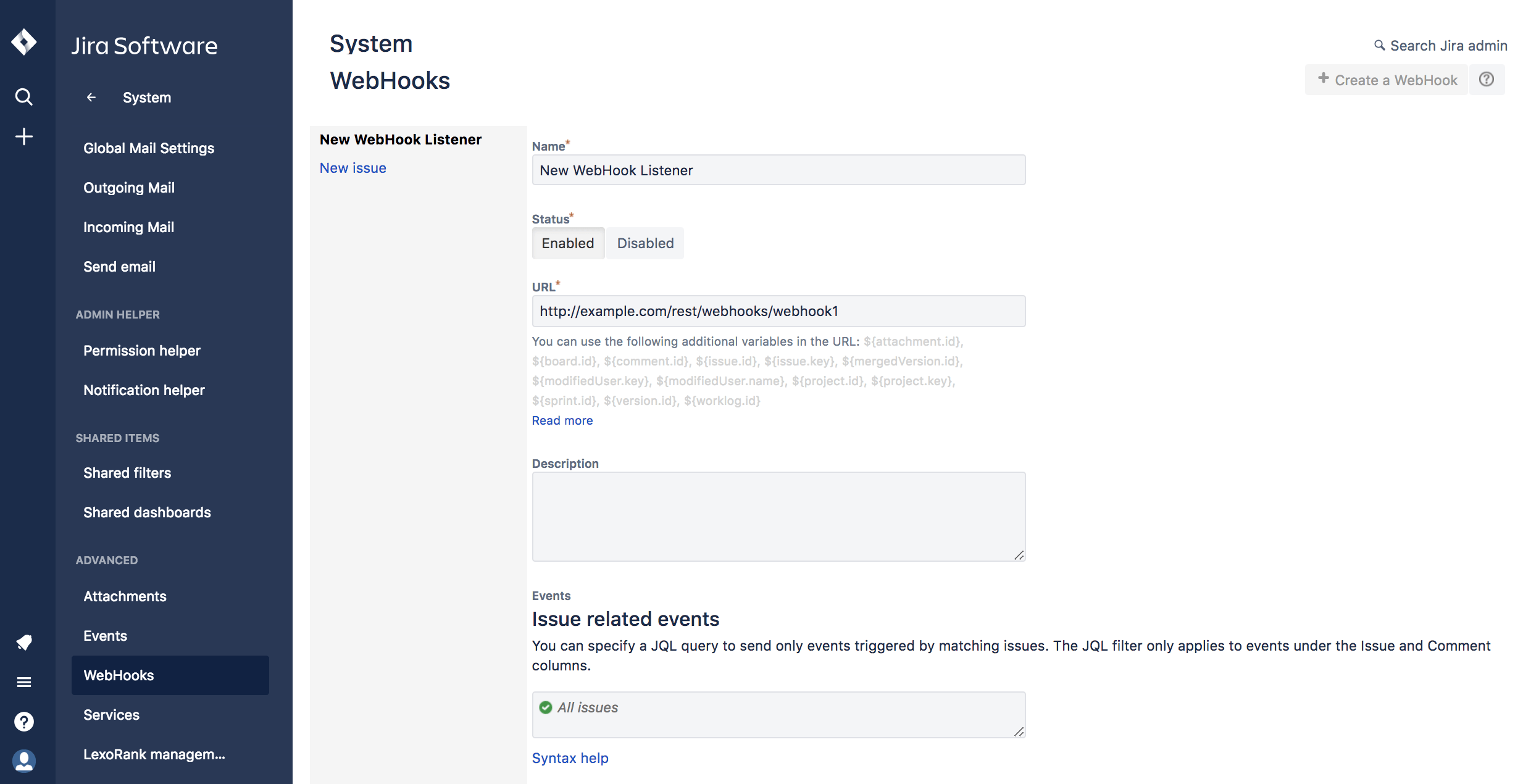 Form for registering a Jira webhook
Form for registering a Jira webhook
Enter the details for your new webhook in the form:
- Enter a name for your webhook.
- Set the status to Enabled.
- Under URL, paste the target URL of the HTTP webhook trigger your Jira user is using for their recipe.
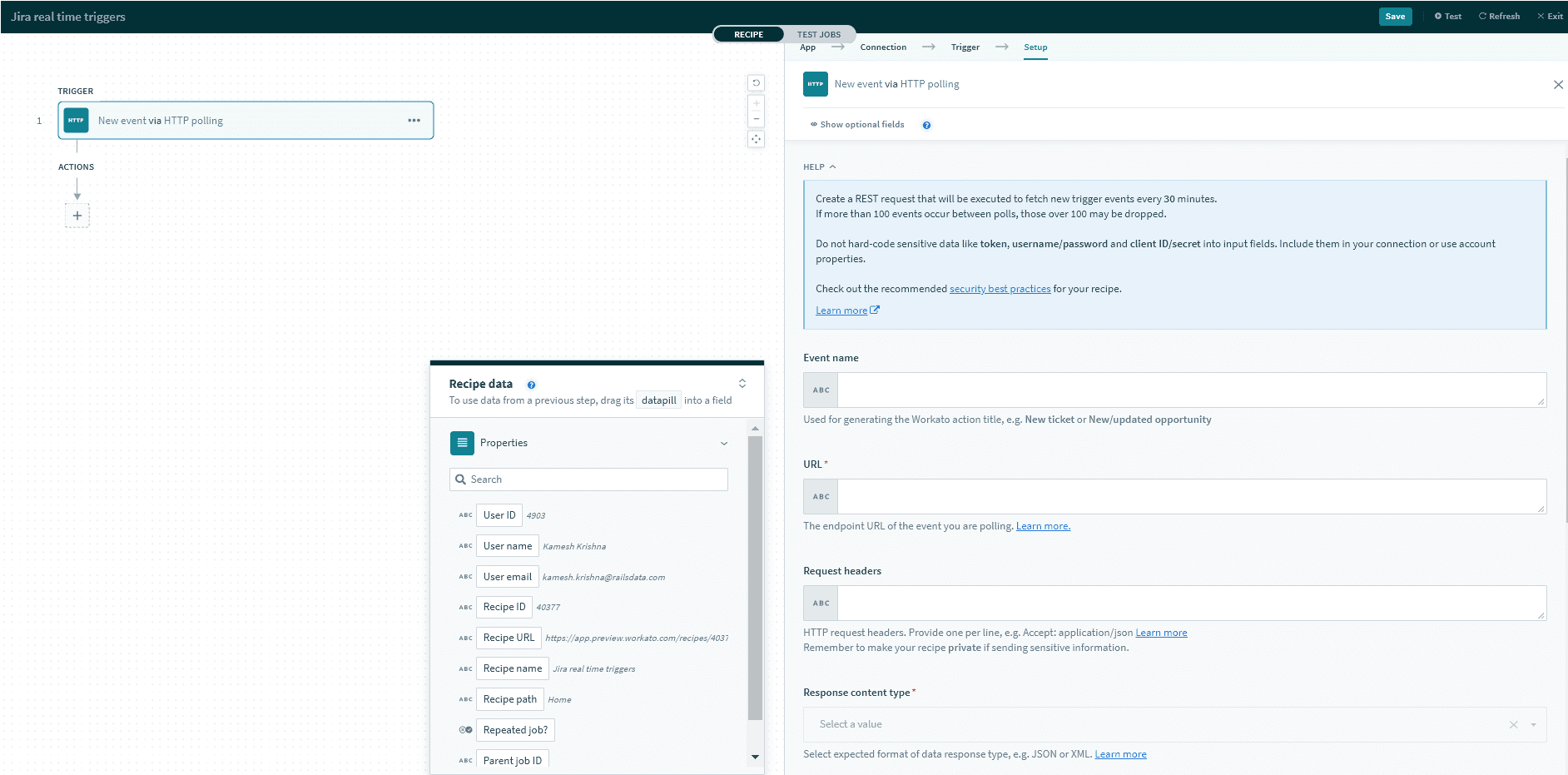 Obtain the URL from an HTTP 'New event through webhook' trigger in the Jira user's recipe
Obtain the URL from an HTTP 'New event through webhook' trigger in the Jira user's recipe - Check the boxes for the Jira events you plan to listen to, then click Create. For a full list of events and how to configure them, check out the Jira documentation for available Jira webhook events (opens new window).
Last updated: 9/18/2025, 6:41:03 PM